Typing on the keyboard is important for everybody who uses their computer. It is significantly important for children. Touch typing for kids is more than a way to press keys quickly - it's a skill that can shape the way children write, learn, and even think. The difference between typing with two fingers while looking at the keyboard and true touch typing is dramatic. Children who don't use the correct typing technique constantly break their flow, their eyes darting down to the keyboard for every letter. They lose their rhythm, and their concentration on the content they write diminishes. Learning touch typing changes that entirely: it allows children to type as naturally as they speak, turning the keyboard into an invisible extension of their thoughts.
This early mastery of typing matters because habits formed in childhood often stay for life. A child who learns proper typing from the start won't have to unlearn wrong and inefficient habits. Instead, they grow up with a skill that, once mastered, is effortless. Their fingers know where to go. Kids who type without looking at the keyboard focus on what they want to write. And every writing assignment becomes easier to accomplish because of it.
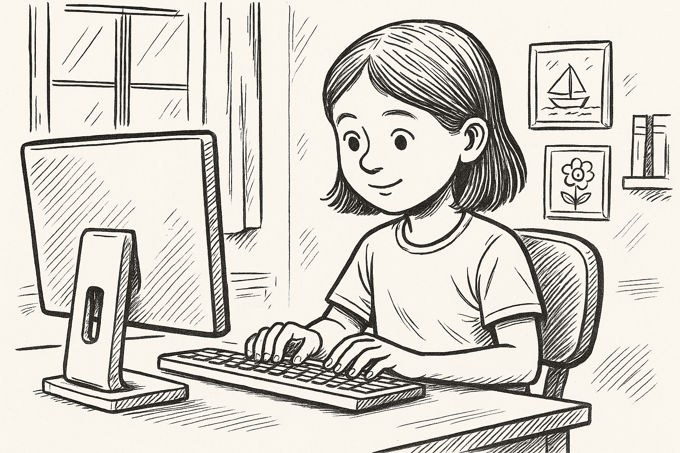
There's also a broader truth: touch typing for children isn't just about speed. It's about confidence, focus, and independence. It helps them work better at school, communicate better online, and ultimately sets them up for a lifetime of easier writing and learning. With tools like AgileFingers, which combine structured lessons with fun typing games, this essential skill can be learned in a way that feels like play rather than homework.
Touch typing in schools – Why it matters
Many more classrooms than before depend on computers. Writing assignments, research, and even tests are done on screens. Yet many children are still left to "figure out" typing on their own. That often means years of inefficient typing, leading to slower work, more frustration, and lost time to focus on the real learning. Typing lessons in school change this. When schools introduce typing practice for kids, they aren't just teaching a new skill - they're removing an obstacle for kids' efficient development.
Teachers who bring structured typing lessons into the classroom see the difference quickly. Students who type fluently finish assignments faster and contribute more confidently in computer-based lessons. They focus on the subject instead of wrestling with the keyboard. For the slower typists, learning proper technique is often a relief - they finally feel like they can keep up. For teachers, it means fewer students falling behind, not because of what they don't know, but because of how slowly they type.
Scrupulousness and patience
Touch typing isn't something children pick up instantly, and that's a feature of learning to type without looking at the keyboard. Kids at first struggle learning touch typing, their eyes sneak downward, and mistakes feel constant. But with each practice session, they see small improvements. Children learn that effort, repeated over time, brings results. That lesson in patience is not only significant in the context of learning to type on the keyboard correctly, but learning in general.
In a world where many activities promise instant rewards, learning touch typing reminds children that some things take time—and that's okay. The discipline they develop at the keyboard translates into schoolwork, music practice, sports training, and other personal challenges. Children who learn to stay with the learning process, even when it's slow, are also learning how to approach bigger tasks in life.
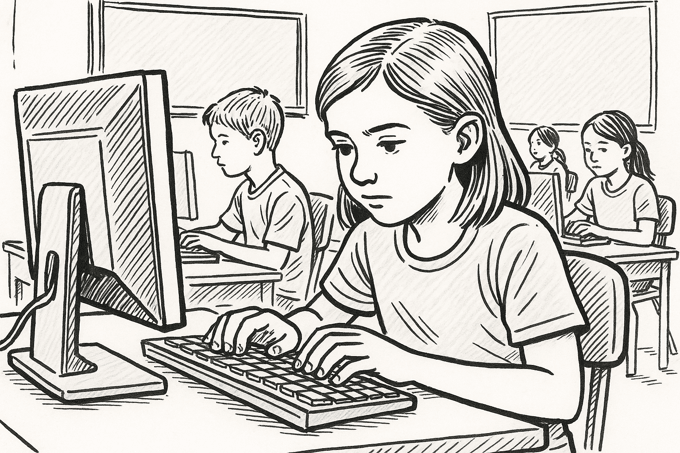
Improved accuracy and focus
Good typing technique teaches good body habits. Children learn to sit upright, feet flat, wrists relaxed. These small details matter more than they might seem - they prevent the slouching and uncomfortable sitting angles that lead to spine aches, headaches, or worse, long-term posture problems. The aches may not occur in childhood, but they will develop later in life.
By introducing typing practice for children early, schools and parents can establish these healthy habits in kids who should avoid bad typing habits. A child who learns to sit properly at a desk won't have to "fix" posture later. Touch typing encourages correct sitting posture and allows you to type the right way without thinking about it.
Better Posture and Ergonomics
Proper touch typing encourages good posture. Typing with both hands placed correctly on a keyboard and eyes on the screen promotes a neutral, healthy sitting position. Children who practice regularly while maintaining correct ergonomics are less likely to develop posture-related issues such as back pain, carpal tunnel syndrome, or spinal misalignments. In contrast, children who constantly look down at the keyboard when typing often develop bad habits that may be difficult to break later in life. Starting with good habits from the beginning helps create a foundation for physical well-being and efficiency.
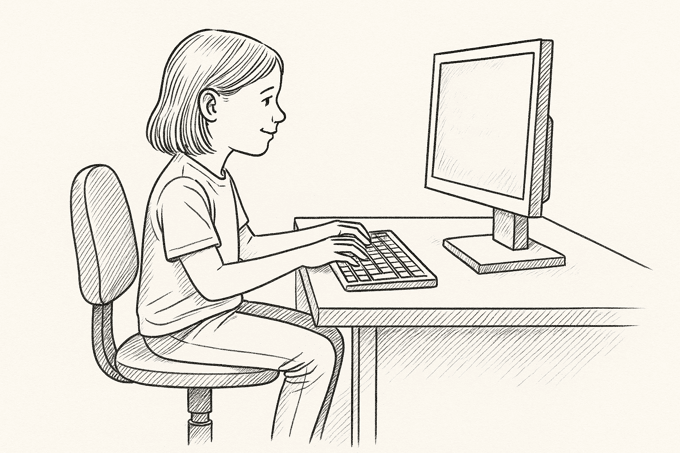
A Step Toward Career Readiness
In the modern workplace, digital fluency is no longer optional—it's expected. Touch typing remains one of the foundational skills in today's computer-centric world. Children who learn this skill early have a distinct advantage when applying for jobs later in life. Whether they become writers, programmers, designers, or data analysts, the ability to type quickly and accurately boosts productivity and makes a strong impression on potential employers. It signals professionalism, conscientiousness, and precision—qualities every employer values.
>Typing games for kids - Learning through play
Children learn best through play. This isn't just an educational theory—numerous studies in developmental psychology confirm that playful learning leads to greater retention and engagement. AgileFingers recognizes this and incorporates playful learning in its design. With engaging games such as Word Jumper game for learning touch typing, Sheep Rescue game, and Star Words typing game, children learn the fundamentals of typing without even realizing they are practicing. Each game is tailored to different levels, focusing on letters, whole words, or advanced phrases, which makes learning dynamic and fun.
These typing games for children keep practice from feeling like school work or something boring. They motivate kids to return day after day, and without even realizing it, they are memorizing keyboard layout, improving speed, and gaining accuracy. Teachers can use these games as short warm-ups in the classroom or a reward for finished work. Parents can use them as a productive alternative to mindless screen time. The result is the same: typing becomes a skill kids want to practice.
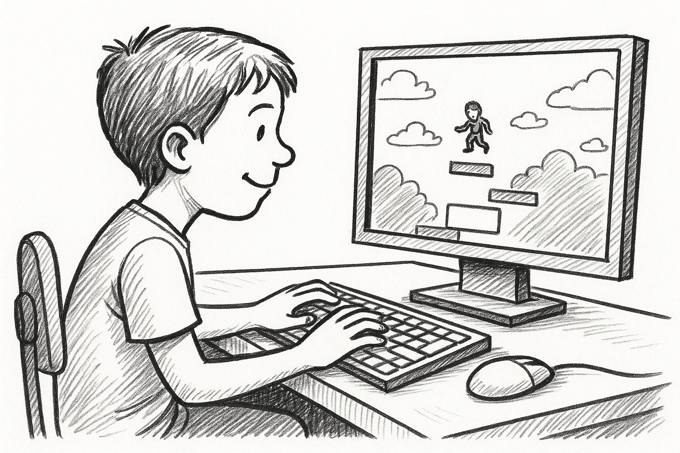
Typing and brain development
Typing might look simple from the outside, but neurologically, it's an advanced skill. When kids learn to type, they are building procedural memory - the same type of memory that helps us ride bikes, play instruments, or tie shoelaces. At first, every key requires conscious thought. Then, through repetition, the hands simply type automatically.
That automation frees the brain for what matters: ideas. Instead of thinking about which key to hit next, children focus on what they want to say or express. Studies even show that typing can support spelling and grammar, because the instant feedback of seeing mistakes and correcting them reinforces the right patterns. For students learning a second language, typing helps new words "stick" in both mind and muscle.
Boosting confidence and independence
There's a special kind of confidence that comes from mastering a skill that once felt impossible. When kids notice they're typing faster than before, when homework that used to take an hour now takes thirty minutes, when they can write an email to a teacher without help - that confidence grows.
Typing independence isn't just about words per minute - it's about self-belief. A confident typist is often a more confident student. They feel capable and self-sufficient, which spills over into how they approach all kinds of learning. They stop seeing typing as a hurdle and start seeing it as a tool they fully own.
An Investment in the child's future
Touch typing for children pays dividends for the entire life. In primary school, it means essays and stories come more easily. In high school, it means less stress on exams and more time to think. In university, it means notes, research, and papers can be produced more fluently. In any future career that concerns computers, touch typing quietly boosts productivity in almost every task.
The difference between someone who types effortlessly and someone who struggles isn't just time saved - it's an entirely different experience. A child who learns proper typing won't stop mid-thought to search for letters; they'll write, create, and communicate without interruption. That ease shapes everything they do with a keyboard for the rest of their lives.
Typing in school – A teacher's perspective
For teachers, adding typing lessons can seem like just one more thing. But the truth is, teaching children to type doesn't take over the entire computer science lesson - it supports it. Short practice sessions - ten minutes at the start of class or after students finish their main assignments - keep them engaged. That way, students who are done with their lesson assignments are not bored or disruptive while others are still working. Playing games that learn typing or completing other AgileFingers activities helps kids warm up for writing, improves their focus, and gradually transforms each student into a faster, more confident computer user.
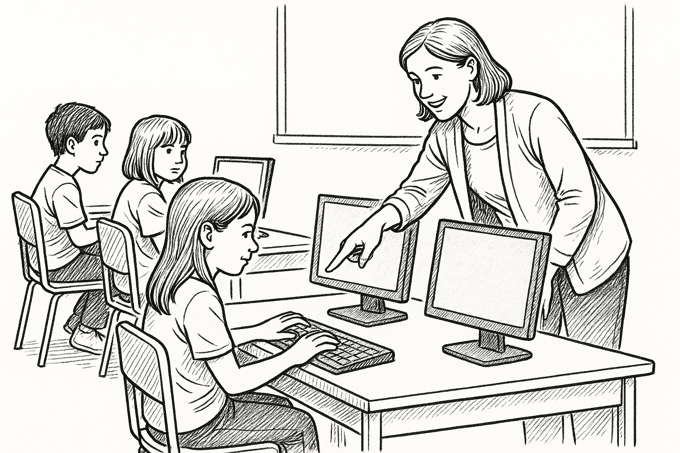
Schools that adopt typing classes for kids often see improvements in all written assignments. They finish online tests on time. They communicate more clearly. And they stop seeing the keyboard as an obstacle—because they've learned how to use it the right way.
Supporting language learning and cognitive growth
Typing supports language acquisition and literacy. As children type, they reinforce spelling, grammar, and vocabulary. The mechanical process of typing words helps with memorization, while the rhythm of typing reinforces getting used to correct sentence structure. Children who learn typing early may even experience improvements in reading and writing fluency.
Typing exercises as a daily routine
Like any important skill, typing gets better with regular practice. It doesn't need hours - it needs consistency. Ten or fifteen minutes of daily typing practice builds fluency surprisingly fast. Programs like AgileFingers make this routine easy, offering lessons, challenges, and the right mix of structured learning and fun. Kids track their progress, see milestones, and typing becomes part of their day, not a chore.
Conclusion
Typing for kids is more than just learning to hit keys- it's a foundation for success in school, confidence in writing, and fluency in every future job. Teachers incorporating touch typing into their computer science lessons and parents who support it at home aren't just teaching a skill - they're giving children a tool that will serve them for a lifetime. With patience, playful games, and a little daily practice, touch typing turns from a lesson into a natural interaction with a computer - a quiet but powerful advantage that children will use for years to come.